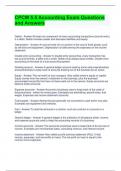Exam (elaborations)
CPCM 5.5 Accounting Exam Questions and Answers
- Course
- Institution
CPCM 5.5 Accounting Exam Questions and Answers Debits - Answer-At least one component of every accounting transactions (journal entry) is a debit. Debits increase assets and decrease liabilities and equity. Depreciation - Answer-An annual write-off of a portion of the cost of fixed assets, such...
[Show more]



